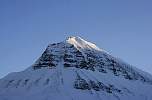
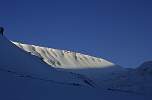
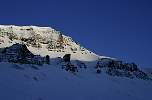

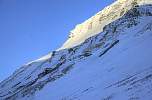
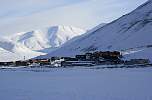
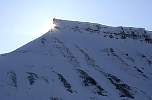
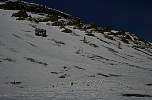
About two years after going to the South Pole, I went to the North Pole.
Tours to the North Pole are generally pretty similar to tours to the South Pole. In both cases you have just one company providing a base camp on the ice (even though trips may be offered by other companies, which use the logistic support of the base camp operators), the camp is only there for a bit more than a month before it gets completely dismantled, you fly with a transport plane to the camp and then with another aircraft to the pole.
But generally trips to the North Pole are easier (and cheaper) since the distances involved are smaller. While Punta Arenas, the starting point for the South Pole, is more than 4000 km from the South Pole, Longyearbyen is less than 1400 km from the North Pole. In fact, Longyearbyen is closer to the North Pole than Punta Arenas is to even the coast of Antarctica.
| Antarctic | Arctic | |
| Logistics | ANI/ALE | VICAAR |
| Starting place | Punta Arenas (Chile) | Longyearbyen (Svalbard/Norway) |
| To Pole | about 4000 km | about 1400 km |
| Camp | Patriot Hills | Barneo |
| Position | About 80°S | About 89°N |
| To Pole | about 1200 km | about 120 km |
| Camp active | Dec/Feb | Mar/Apr |
| Transport to base | Ilyushin Il-76 | Antonov An-74 |
| Transport to Pole | DHC-6 Twin Otter plane | Mil Mi-8 helicopter |
So, if it is essentially just a scaled down version of a trip already done, why go to the North Pole at all?
Except for the obvious answers "Why not?", "because I haven't been there" and "for a sense of completeness", there are two main (and a couple of minor) reasons that made me go.
First, when flying to the South Pole, there were actually two planes going south. One for the 'day trip' visitors to the South Pole and the other one for a small group of 'last degree' travellers. They were dropped at 89°S and would ski the last degree towards the South Pole.
While I would not contemplate travelling 120 km on skis in cold weather and thin air, especially having no skiing experience, I watched them with a certain amount of envy. What they were doing looked like fun and also just the right thing to do.
So when I looked at the trip offers for the North Pole, I noticed that there was something called "Walk to the North Pole", where they drop you off a couple of kilometers from the pole and you ski the rest. So it wasn't as long or exhausting as a 'Last Degree', but something that seemed like fun, well within my capabilities, the right way to get to the North Pole, something that I regretted not being able to do at the South Pole and it also made the trip somewhat different from being just a rehash of the South Pole trip.
Good enough reasons to go.
And second, when we came back from the South Pole, we had a refuelling stop at Thiel Mountains. At that time the weather at Patriot Hills was pretty bad, so the plan was to try to fly to Patriot Hills and, should we be unable to land there, fly back to Thiel Mountains and camp there for a day or two. We managed to get to Patriot Hills, but the idea of camping somewhere 'out there' and not spend the night comfortably at 'base camp' appealed to me and I was slightly disappointed that we managed to land in Patriot Hills (though, at that time, hugely relieved).
And the "Walk to the North Pole" trip included a night at the pole. So I would be able to do some 'cold weather camping' (and, as an added bonus, be able to spend more time, about 18 hours, at the at Pole).
So, from this perspective, it wasn't just a poor remake of an earlier trip, but more like the other puzzle piece, fitting in the blanks from the previous journey, making a complete experience. Yes, I am pretty bad in writing pseudo-poetic travel imagery. It won't happen again, but I just had to do this one.
But whatever the reasons, it was a pretty neat trip.
Starting place for the North Pole trip was Longyearbyen in Svalbard. I had been to Svalbard ten years earlier and the feeling was similar to visiting Ilulissat in Greenland the previous year. About a decade ago, Ilulissat and then Svalbard were the northernmost places I thought I'd ever go to, and last year Ilulissat became 'just' a transit place to go to Qaanaaq in Greenland and now Longyearbyen became 'just' a transit place on the way to the North Pole.
But never mind that...
Weather in Longyearbyen was pretty nice. About -15°C (5°F) and sunshine.
When I arrived at the airport, it was time to get some clothing. VICAAR has their storage (and essentially their Svalbard base of operations) directly at the airport, so I was met at the airport and taken directly to the 'warehouse', where I received a big duffle bag with stuff. I was aware that, except for the underwear, almost everything would be provided for the trip, but I hadn't quite realized that I would get to keep all the stuff (on the trips to the South Pole and Greenland the 'serious stuff' like boots, windproof pants and parka/anorak were rented).
Then it was time to head for the hotel (well, actually the guest house in Nybyen) and do sort through the stuff and mix-and-match between the stuff they issued and my own stuff.
Around noon next day, I had to head back to the airport to get the sledge packed out. The ski trip to the North Pole would involve pulling a sledge with equipment (such as a sleeping bag, tent, cooker, food). Since the weather was fine, the airport is only about four kilometers out of Longyearbyen and I wanted to try out the boots, I walked to the airport.
Along the way I encountered the probably most pointless warning sign in Svalbard.
I somewhat expected penguin jokes (because of the usual penguin/polar bear Antarctic/Arctic divide), but kangaroos?
The footpath to the airport passes next to the funicular centre. Longyearbyen started out as a coal mining town (there still is one active coal mine, but there used to be seven of them) and the coal was transported from the mines in large buckets on a long steel cable. At the funicular centre, the coal was transferred from the individual lines coming from the mines to the line going out to the harbour.
None of the cables is active anymore (and on the pillars going out to the mines, most of the cables are long gone) and nowadays the coal is brought to the harbour by truck, but close to the funicular centre the cables still exist and some coal buckets can still be seen.
The way to the airport was uneventful, and the boots turned out to fit and be no problem at all.
The sledges for me and my guide were already pre-packed, with one tent, two sleeping bags, two sleeping mats, a fuel cooker, two fuel bottles, a kettle, a pan and a cooking pot and four boxes with food (one per person for the day at the pole and an extra box per person in case of emergencies). I also got to pick a pair of skis and ski poles and, since I didn't have any real skiing experience, a pair of snow shoes, just in case that the "Walk to the North Pole" actually became a walk.
I have to add a note here. When I came to Longyearbyen, I stated that I had no experience skiing, which quickly turned into "this was his first time on skis". This was close enough to reality anyway, so I didn't correct it, but just for the sake of correctness: When I was at Patriot Hills in Antarctica, we had a couple of days delay on the trip back, since the plane from Punta Arenas could not get in. To pass the time, they gave us a short skiing lesson and also lent me a pair of skis, so I could ski around the camp a bit. (I really enjoyed being outside there and instead of just standing around at the edge of the camp, taking in the view and the wind, I could now move around the edge of the camp.) So I had been on skis before, but just essentially just shuffling around a bit.
Nothing else to do for the day, so I did some sightseeing in Longyearbyen.
I passed by a memorial to the conditions that used to exist in the coal mines.
I also went to some nice viewing place that allowed great views along the Adventdalen, towards the Hjortfjellet mountain, across the Isfjorden and towards Longyearbyen.
I wasn't the only one enjoying the view. A ptarmigan had landed nearby and just kept sitting there, more or less ignoring me.
On the way back to the guest house there was one of these typical, almost circular, polar cloud formations,
To give a sense of scale to the surroundings of Longyearbyen - the group of dots on the snowfield in the lower right of the following picture are actually two skiers pulling sleds.
Next day it was time to fly to Barneo Camp. (I've seen that on some web sites as Barneo and on others as Borneo. I assumed that this was just some ambiguity in the transliterating rules from the Cyrillic alphabet. But it turns out that the camp originally was called Borneo, based on its original call sign and that they later intentionally changed it to Barneo to avoid ambiguity and 'diplomatic conflicts with Indonesia'.
Things got a bit chaotic at that point. I didn't quite realize it at the time, but what happened was roughly: I was the only client who booked the "Walk to the North Pole" trip directly with VICAAR, so I would pair up with a guide from them (hence the two sledges - one for me, one for the guide). The guide was still somewhere on the ice, but (I'm not quite clear on that), he would either come with the previous plane from Barneo Base or I would just meet him at the base.
But the guide got sick, so I was essentially stranded without a guide. So VICAAR asked Eric Philips (from Icetrek Expeditions) whether he would take me as a client. He was doing a "Walk to the North Pole" with his own clients, so he was "going the same way" and he agreed to take me to the Pole as well.
This turned out to be quite a stroke of luck for me, since Eric is an extremely experienced and very good guide (which are not necessarily the same things), whom I wouldn't have gotten as a guide otherwise. It also brought me together with a very unusual pair of polar travellers. His other clients were Heinz and Lyndy, a couple living (mostly) in Vermont, but are originally from Switzerland. While it's probably slightly impolite to mention, I have to refer to their age at least once. Heinz is 79, Lyndy is 76. Which is quite a bit above the average age of couples that ski to and camp at the North Pole. But both are extremely active, both are flying their own balloons, Heinz flies his own plane, they also sail and scuba dive and do various other kinds of outdoor activities.
So it was a rather unusual group that I had coincidentally gotten into. (Though, to be fair, almost every group travelling up there tends to be somewhat unusual.)
Before going to the boarding area at Longyearbyen airport, we went to the VICAAR warehouse to get the sledges and bags ready for loading. Someone had re-packed my sledge (since originally there were two sledges - one for me and my guide), so that I had a sensible set of equipment with me (since it wouldn't have helped much if I got the cooker and two sleeping bags, with the tent and the kettle remaining in Longyearbyen). Luckily Eric noticed that I had no skis. I had tied them to my sledge the previous day, but it seems that during re-packing they were put back to storage. So he quickly got me another pair of skis and everything was ready.
(Yes, basically it would have been my responsibility to make sure that everything is there and properly packed, but, as I mentioned, things had been a bit chaotic and I just assumed that all skis were already bundled somewhere else and taken on the plane. Part of the confusion came about since at that time I knew that Eric was the guide taking me to the Pole, but I didn't know that he wasn't the guide that was supposed to take me, so I figured that if someone had moved the skis somewhere, it would have been him. He, on the other hand, probably just noticed a confused client planning to ski to the Pole without any skis.)
But it was sorted out quickly, so, as they supposedly say in Australia, "No worries!". (Even though I never really heard that phrase in Australia outside a tourist office.)
Time to go out of the warehouse and into the airport proper and through the security check. Looking out towards the runway, the plane seemed oddly old-fashioned.
It wasn't the plane we were going to take. The plane belongs to the Alfred-Wegener-Institut, the German polar research institute. Essentially it's a modified DC-3 (the formal type is "Basler BT-67" and the plane is named 'Polar 5' and was put into service (as a "Basler BT-67") about half a year earlier - no idea from what year the original DC-3 was).
But it drove an important lesson home. In polar regions durability and proven reliability are always more relevant than modern conveniences. (Durable and reliable conveniences are welcome, though...)
We walked over to 'our' plane, the Antonov-74. VICAAR had two of them available, both chartered from Gazpromavia, an airline operated by Gazprom.
Unlike the Ilyushin Il-76, which took me to Antarctica and was configured as a transport plane, the Antonov had regular seats in the front and
The flight was nicely uneventful and relaxed. Unfortunately there wasn't much to see (only the seats near the front had windows), but there was lots of going back and forth in the plane, so I managed to get a good look at the sea ice during the flight. A couple of wide leads, but mostly large and stable looking ice plates. And this was still some distance away from Barneo and the Pole, so the 'terrain' looked promising.
But polar travel still differs a bit from 'normal' travel, which we evident when someone went down the aisle of the plane with a transparent bag of shotgun shells, asking "whose are these?". On a normal flight, this would probably have been somewhat disconcerting, but up here, it was pretty normal. Since all guides needed to carry a weapon (due to a small possibility of polar bears), they also needed ammunition, which they couldn't take through normal airport security. So the ammunition was given by the ground personnel to the pilot, who, under normal circumstances, would hand it to the ground personnel at the destination, who would then hand it to the owner. Since there was no ground personnel at Barneo Base (and the pilot had lots of other things to do during the short time on the ice runway), ammunition was returned to their owners after take-off.
Odd, but comfortingly sane. (Unlike most airplane security nowadays...)
After about 2:15 hours, we landed on the ice at Barneo. This year the ice was quite thick, at about two to three meters, so there was a comfortable margin of safety for landing a plane. (About 1.5 meters of ice thickness are usually sufficient.)
Time to leave the plane and get out on the ice, to unload the sledges and walk over to the camp for a hot soup and a short info session.
The plane departed shortly thereafter.
The camp is modular, well structured and organized. A large main tent that serves as a mess hall and meeting room, two groups of four half-cylinder tents with beds for ten people each, smartly connected to a central heating system (the space heater is somewhere outside, feeding warm air through plastic tunnels to the tents. And a couple of 'staff only' tents connected to the mess hall. And that's essentially it.
The atmosphere is an odd mixture between base camp and tourist resort. While most of it is essentially utilitarian and no frills, we are greeted by someone in a polar bear costume, which looks more like belonging to Disneyland or on a cruise ship than on the ice. (Technically, it's a great costume, though. It's not overly cute and it is inflated by an internal fan, so it looks quite impressive and massive when 'in action'. Unfortunately, I only have 'getting the costume ready' pictures, which don't show the costume at its best.)
There's also a signpost showing distances to all kinds of places (actually these are distances from the North Pole, not from the camp - presumably it gets taken to the Pole for pictures from time to time).
At the camp entrance there's also a large snow sign saying "Barneo". Setting up the camp was rather late this year, so the sign is not quite finished (the 'e' still needs some work).
In the meantime, the first travellers already return from the North Pole. There is a 'day trip' from Longyearbyen available, where the clients fly in with the morning flight to Barneo Base, then take the helicopter to the North Pole and fly back an hour later to catch the afternoon plane back to Longyearbyen. So while I was looking at the camp and taking pictures, they were already at the North Pole. Someone with a large 90° flag is with them. So it looks like they don't usually take the whole signpost with them, just the flag.
Shortly afterwards, the afternoon flight arrived from Longyearbyen and they left with it shortly afterwards.
In addition to the Antonov 74 and the MI-8 helicopter, there was also one aircraft that was not of Russian origin, a DHC-6 Twin Otter. It looked quite familiar. It belonged to Ken Borek Air, the same company that provided the Twin Otters used at Patriot Hills base, which took me to the South Pole. The Twin Otter here at Barneo just had spent the (Antarctic) summer at Patriot Hills and was now doing service in the Arctic. It would have been a neat coincidence if that had actually been the same Twin Otter that took me to the South Pole two years earlier, but didn't turn out to be.
Then came 'the moment of truth' for me. I had already mentioned to Eric that I had no previous
skiing experience and asked him whether he was a good teacher.
"Well, it's not really difficult. Can you ice skate?"
"No"
"Roller skate?"
"No"
"Skate board?"
"No"
"Water ski?"
"No"
"Wind surf?"
"No"
"Well, it's not really difficult anyway."
So we had a bit of a test run around the camp. (Heinz and Lindy already had a test run with Eric the previous day in Longyearbyen, but at that time neither them nor me did know that I would be part of their group.)
Luckily, it turned out to be quite easy. Just shuffle your feet forward until you reach your destination. I could do that...
And I'm not overly fatuous here. The bit I was worried about is that there is a bit of technique to normal cross country skiing, where you glide quite a bit on your skis (and which I never managed to achieve while moving around Patriot Hills). But since we were pulling pulkas, we had felt on the underside of the skis (not just a short strip, but covering the whole length), so gliding was out of the question anyway.
So it was really just shuffling along without lifting your legs. Not that difficult. A bit like the zombie version of cross-country skiing. I wonder whether there ever had been a revue "Zombies on Ice". I would have fitted right in...
In the evening then a short equipment check with Eric. I had taken most of my gear and also the gear provided by VICAAR and it was clearly too much stuff by a wide margin. So we went through the stuff and Eric told me: "Leave that at camp.", "And this." "And this as well.", "You won't need this.", "This neither.", "This is much too warm."
Which leads me to my "How to spot a very experienced guide (but too late to do you any good)" theory: When a guide tells you something that clearly contradicts "common wisdom" (i.e. everything you read in preparation of the trip) and the advice turns out to be right, the guide is very experienced.
The downside of this is, of course, that you won't know whether the guide is right until later, at which time the advice could turn out to be disastrously wrong.
Luckily, Eric is a very experienced guide.
To be more specific: Every guide book to polar regions tells you that you need to dress in layers. You need some long underwear, designed to wick any sweat away from your skin, a fleece layer to trap the heat and an outer, windproof shell. Preferably, the fleece layer consists on multiple fleece garments, so you can add or remove layers to regulate heat.
So with -29°C (-20°F) expected at the North Pole, Eric told me to forget about the fleece pant and just wear some long underwear and the windbreaker trousers I got from a supermarket in Greenland the previous year. For the upper body, it was just long underwear, the thinnest fleece I had with me ("Polartec 300? Much too warm. What else have you got?") and a parka.
Admittedly, that was more or less what I had been wearing in Greenland, when I was out on the ice on my own (and I was quite comfortable with this), but I never expected this to be an actual recommendation. (Especially after the South Pole, where, under similar conditions, the advice was basically to wear lots. And then some.)
Another advice that surprised me (but which I liked quite a lot) was not to bother with sunglasses. Every book tells you about the dangers of UV exposure, the reflections of the sun on the ice and the twenty-four hours of sunshine. And that you should wear sunglasses, preferrable glacier glaces all the time. Even for short trips. Even when it's cloudy.
Eric: "You don't really need to wear sunglasses. At this time of the year, the sun is still too low in the sky to be anything to worry about. I usually don't bother."
Which suited me fine, since behind sunglasses you always feel a bit detached from your surroundings and I prefer to go without, but I wouldn't have dared, since every guide book tells you how dangerous it is. Experienced guides are a good thing.
This was followed by a short lesson on how to light the stove, followed by a rather longer lesson on how to deal with a stove that is not working properly. Essentially that means to find someone who is even more experienced with the burner and gives it a good, but well placed, kicking. (The last bit is not quite true. The real procedure is draining any residual fuel from the burner and start from scratch.)
A couple more photographs around the camp and then off to bed.
Russian flag and two bears (Russian and polar) hugging it.
Mess hall at Barneo ice camp. And bar. And souvenir shop. And recharging station. And waiting room. And info center. And coffee source. And about everything else that is not sleeping quarters or toilets.
The doorknobs at the doors of the tents were surprisingly ornate.
The toilet facilities looked more elaborate then they were. They are just empty shells to protect you from the wind, standing over a hole in the ice over which you squat.
After a short night (I was too excited to sleep properly, so I got up early, enjoyed the scenery, drank some coffee, wrote some postcards, ate breakfast) it was time to head north.
Everyone got into their gear and waited for the helicopter to be ready to take us close to the Pole.